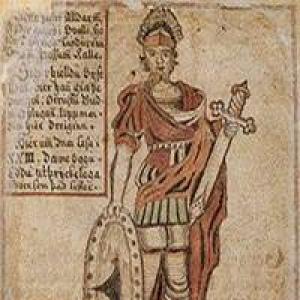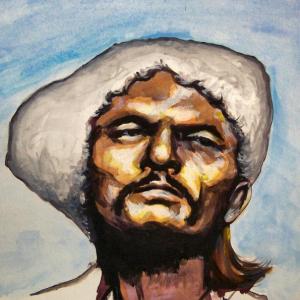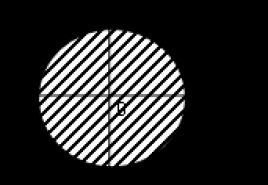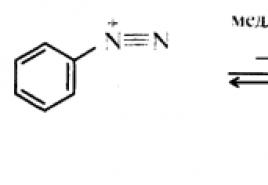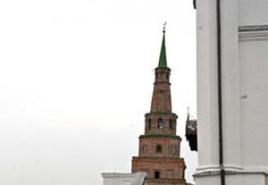Who are the Denisovans briefly? “Denisovan man” “inherited” most of all in the genome of Asians
The fact that the species of ancient people discovered in 2010 in the Denisova Cave in the Altai Mountains was more culturally and spiritually developed than its contemporary Neanderthal was concluded by the author of the find, Academician of the Institute of Archeology and Ethnography SB RAS Anatoly Derevyanko. They say that the life around him was too advanced for those times - the Denisovan could not only sharpen tools well, but even drill holes, and made a lot of interesting decorations. Now the cultural superiority of the Denisovans over the Neanderthals has been confirmed by geneticists. And in general, we found out a lot of interesting details...
The Denisovan knew what was “good” and what was “bad”...
As the basis for our research, we took DNA samples from both Denisovans and Neanderthals, as well as other varieties of ancient people aged from 30 to 40 thousand years and older,” Dmitry Afonnikov, candidate of biological sciences, head of the laboratory of evolutionary bioinformatics and theoretical genetics of the Institute of Cytology and Genetics SB RAS, told Komsomolskaya Pravda. . - And compared their microRNAs. For those who don’t know, this is a gene structure that interacts with matrix ribonucleic acid and regulates the synthesis of proteins in a group of genes at once.
Simply put, microRNA is a natural stop valve, which, like an arbiter, decides which traits will dominate in us and which ones will die out. So, as it turned out, 3 microRNAs in Denisovan and 7 in Neanderthal turned out to be especially interesting. However, they performed completely different functions - thanks to them, Neanderthals became stronger, and Denisovans became smarter. And beyond his years!
In order to somehow adapt, Neanderthal man had to have good tissue regeneration,” says researcher at the Institute of Cytology and Genetics SB RAS, Candidate of Biological Sciences Konstantin Vladimirovich Gunbin, “And we were lucky enough to find those microRNAs that are precisely responsible for these processes. But in the case of the Denisovan, they directly regulate the work of genes that are responsible for the formation and functioning of the prefrontal zone of the cerebral cortex - it is primarily responsible for receiving and processing information, as well as the ability to live normally in society, distinguish between good and bad deeds and foresee consequences of your actions.
...and “got smarter” faster than modern man!
Moreover, scientists believe that the brain of the person from Denisova Cave developed even faster than that of the modern one.
This is evidenced by the number of mutations in the genes responsible for the frontal zone of the brain, explains geneticist Dmitry Afonnikov. “The Denisovans have a lot of them, so we can say that they “got smart” faster than modern people. We cannot yet say this unequivocally. But experience suggests that everything was exactly like that - in any case, the minds of modern humans and monkeys evolve according to such an algorithm.
But, as you know, both branches - Neanderthals and Denisovans - turned out to be dead ends. Which, however, does not mean that they disappeared in the dust of millennia without any trace. For example, ancient homo sapiens, as a result of crossing, borrowed immunity against viral infections from Denisovans. This is especially true for the inhabitants of distant Malaysia - it has already been established that their ancestors “became friends” with the Denisovans most closely - forever accepting from 4 to 6 genes of “Altai Man” into their gene pool.

From the KP dossier
In the scientific journal "Nature" in 2010, two publications were published concerning the phalanx of the little finger of a creature found in 2008 in Denisova Cave in Altai by scientists from the Institute of Archeology and Ethnography of the SB RAS. Among the authors of the materials are the Director of the Institute, Academician Anatoly Panteleevich Derevyanko and his deputy for scientific work, Doctor of Historical Sciences Mikhail Vasilyevich Shunkov. The research was carried out by an international team with the participation of both Russian specialists and the famous paleogeneticist Svante Paabo from the Max Planck Institute for Evolutionary Anthropology (Leipzig, Germany), who previously led the work on deciphering the Neanderthal genome. The editors of the journal "Nature" also included research into the remains of the most ancient human ancestors in the list of the twelve most significant events of 2010 in the world of science.
Denisovan man (“Denisovan”) is a distinct population of ancient people who diverged from the “mainstream” of human development approximately a million years ago. Denisovan known from fragmentary material from Denisova Cave in the Soloneshensky district of the Altai region of Russia.
Denisovskaya cave in the Soloneshensky region in Altai is so far the only place where direct evidence of the existence of Denisovans has been found - the remains of their life and fossils. For the first time this region was inhabited by people about 65,000 years ago.

Denisovsky man - a fossil subspecies of ancient people, fragments of whose remains were discovered in Denisova Cave in Altai. The DNA of Denisovans is different from that of Neanderthals and the species Homo sapiens, but closer to Neanderthals. The Denisovan branch of humans may have split from the evolutionary tree about 700,000 years ago.
In Denisova Cave were found miniature bird bone needles with a drilled eye, ostrich egg shell beads, necklaces made from animal teeth, pendants made from shells, ornaments made from ornamental stones.

Perhaps these traces DNA point to mass migration of Denisovans through the territories of China, Malaysia, Indonesia and Papua New Guinea to Australia.
“Look where Altai is and where Australia is. How is this possible? How did 4% of Denisovan DNA get to Australian Aborigines?” - Roberts is surprised.
Australia is separated from Altai by 8368 km (for comparison, the length of the Trans-Siberian Railway is 9289 km). This is an unimaginable distance, so many of his colleagues doubt Roberts’ hypothesis.
However, the professor himself believes that everything is possible and representatives of the ancient species somehow made this grandiose journey.
Denisovan DNA had previously been found among Eskimos and other northern peoples.

Eskimos and Denisovan people share common genes
Residents of the northern regions of the planet, where the average air temperature drops to -30 ° C, are carriers of a genome similar to that of Denisovan man, a subspecies of extinct people who inhabited Siberia more than 40,000 years ago.
Temperatures in the Arctic regions of Greenland, Canada and Alaska often exceed –30 °C. A large group of indigenous peoples of the north of Chukotka, North America, the northern territories of Canada from the Labrador Peninsula to the mouth of the Mackenzie River - Eskimos (eskimantzig - “raw foodist”, “one who eats raw fish”) and their subgroup Inuit (people) or Yuits - Siberian Eskimos , survive the cold thanks to a diet of fish and the ability to generate heat from a certain type of fat stored in their bodies.
Scientists compared the genetic data of 200 Greenlandic Inuit with ancient DNA taken from Neanderthals found in the Denisovskaya Cave in Altai.
They isolated two genes, TBX15 and WARS2, that make up DNA similar to the genetic variant of Denisovan man.
The TBX15 gene influences the human body's response to cold and fat distribution. Both genes are active in skin and fat tissue and are programmed differently than in Neanderthals and some modern humans.
Lead researcher Fernando Racimo explained that the Inuit DNA sequence corresponds to the Denisovan genome and is different from other sequences characteristic of modern humans.
A study of Inuit DNA showed that 80% of men have Y-chromosomal haplogroup Q, 11.7% have haplogroup R1,
8.3% belong to other haplogroups.
Leipzig, Germany, under the leadership of Kay Prüfer and Svante Pääbo, studied the nuclear genome of a Neanderthal lady who lived in Altai about 50 thousand years ago. Like any serious research, this work has a backstory. Svante Pääbo and his colleagues began sequencing the Neanderthal nuclear genome back in 2006. This is not an easy task, since ancient DNA has long fallen into pieces and is often contaminated with nucleic acids from microbes and modern humans. However, in 2010, they found out that Neanderthals gave their genes to Homo sapiens living outside of Africa.
Now scientists have obtained a refined version of the genome, in which the position of each nucleotide has been adjusted at least 50 times.
Phalanx of a Neanderthal woman's finger
Bence ViolaThe material for the study was DNA from the phalanx of the ring or little finger of an adult woman who lived in Denisova Cave in Altai. The phalanx was found in 2010 by Denisova Cave researchers Anatoly Derevyanko and Mikhail Shunkov and transferred for analysis to Leipzig.
The Neanderthal population of Denisova Cave should not be confused with Denisovans.
They lived there a little later, about 40 thousand years ago, and although they were related to Asian Neanderthals, they represented an independent group of the genus Homo. by the same group of researchers led by Svante Pääbo and also from the phalanx of the finger.
The genome showed that the parents of the Neanderthal woman were closely related. These were relatives or cousins, or maybe uncle and niece, aunt and nephew, grandfather and granddaughter, grandmother and grandson. Scientists have concluded that consanguineous marriages were common among Neanderthals and Denisovans because they lived in small groups and were limited in their choice of mates. Researchers believe that the numbers of Neanderthals and Denisovans were steadily declining at that time, their time coming to an end.
A comparison of the genomes of Neanderthals, Denisovans and modern humans showed that different groups of hominids in Late Pleistocene, 12-126 thousand years ago, met, communicated and left offspring.
Gene exchange did not occur often, but quite regularly.


Excavations in Denisova Cave
Bence ViolaAbout 77-114 thousand years ago, Neanderthals split into Asian and European populations. Neanderthals who lived in the Caucasus exchanged genes with the ancestors of modern Eurasians and inhabitants of Australia and Oceania, Altai Neanderthals with Denisovan people, Denisovans from unknown caves with the ancestors of modern inhabitants of mainland Asia and American Indians.
The Neanderthal contribution to the genome of modern Eurasians is, according to researchers, from 1.5 to 2.1%.
And the genome of Denisovan man, unlike Neanderthal man, contains 2.7-5.8% of the DNA of some unknown ancient hominids. Perhaps they separated 1.2-4 million years ago from the ancestors of modern humans, Neanderthals and Denisovans. Researchers do not rule out that this mysterious ancestor is Homo erectus, the fossilized bones of which anthropologists have found, but whose DNA sequence has not yet been deciphered. Further research will show whether this is true.
Scientists have compiled a list of DNA sequences that distinguish modern humans from our closest extinct relatives. The list of differences turned out to be quite short. The changes also affect genes responsible for cell division and regulation of other genes. In order to find out how these modifications affected the appearance of modern man and his biology, geneticists need to work further.
It’s interesting how sometimes outstanding discoveries, on the one hand, tell us some important truth, and on the other hand, signal that we still have to get to the bottom of the truth. All this fully applies to the sensations of recent years associated with the identification of previously unknown alternative branches of humanity.
Oleg Makarov
The Altai Mountains are located in such a way that it was simply impossible for numerous migrations of a wide variety of bipedal creatures to go around them. Nearby is a vast strip of steppes running from the Yenisei to the Carpathians, which served as the real “gateway of nations” (usually that part of it that ran between the Ural ridge and the Caspian Sea was called that way). On the other side of the mountains are deserts, opening the way to the Far East and Southeast Asia. Altai contains many interesting and mysterious places, including the famous Denisova Cave with a large grotto - it is always dry, and the hole under the dome gives light during the day and serves as a natural chimney. It is not surprising that representatives of the genus Homo have found refuge in Denisova Cave for hundreds of thousands of years, starting with the Neanderthals, who settled there 280,000 years ago. People of the historical era also left traces there - the Turks and Huns, the creators of vast nomadic empires. During this entire gigantic period of time, people lived here, made tools, ate or butchered animals caught by hunting - bones of a yak, donkey, rhinoceros, and hyena were discovered in Denisova Cave.
 The map shows the migration routes of the ancestors of different groups of Homo sapiens across Eurasia. As you can see, the ancestors of the Australian Aborigines and Papuans were in the same group of people from Africa as the ancestors of the future population of Europe and Asia - they separated from their African relatives 75-62 thousand years ago. However, the “Australian” branch (red arrow) went to Eurasia first, even before the “Europeans” separated from the “Asians” 38-25 thousand years ago (in particular, this refers to the ancestral line of the Chinese - Han). The second wave of migration, which passed through Western Asia, India and Indochina, displaced and absorbed representatives of the “Australian” branch on the continent, and the Australian aborigines and Papuans found themselves isolated for 50,000 years. The map also shows hybridization with Denisovans.
The map shows the migration routes of the ancestors of different groups of Homo sapiens across Eurasia. As you can see, the ancestors of the Australian Aborigines and Papuans were in the same group of people from Africa as the ancestors of the future population of Europe and Asia - they separated from their African relatives 75-62 thousand years ago. However, the “Australian” branch (red arrow) went to Eurasia first, even before the “Europeans” separated from the “Asians” 38-25 thousand years ago (in particular, this refers to the ancestral line of the Chinese - Han). The second wave of migration, which passed through Western Asia, India and Indochina, displaced and absorbed representatives of the “Australian” branch on the continent, and the Australian aborigines and Papuans found themselves isolated for 50,000 years. The map also shows hybridization with Denisovans.
Thus, two dozen cultural layers grew above the natural floor of the cave, filled with artifacts - evidence of the life of a variety of inhabitants. To explore these cultural layers (and excavations here began in the second half of the 1970s), archaeologists had to dig a deep hole. And then in 2008, a famous discovery happened: in Denisova Cave, among a huge array of cultural layers, a tiny bone was found - as it later turned out, the phalanx of the little finger of a young female. We can talk about enormous scientific luck, since this find, plus several other small bone fragments (two teeth, possibly a phalanx of a toe) became the only evidence of the existence of a hitherto unknown species of people on Earth.
 The diagram shows the family tree of sapiens, Denisovans and Neanderthals, as well as great apes, going back to a common ancestor. The threshold after which 24 pairs of monkey chromosomes after fusion resulted in 23 pairs of human chromosomes is shown in red.
The diagram shows the family tree of sapiens, Denisovans and Neanderthals, as well as great apes, going back to a common ancestor. The threshold after which 24 pairs of monkey chromosomes after fusion resulted in 23 pairs of human chromosomes is shown in red.
Informative dice
The surprises continued in 2012, when the work of a group of scientists from the Leipzig Max Planck Institute was published (the team leader was Swedish biologist Svante Peebo). Scientists were able to accurately sequence both the nuclear and mitochondrial DNA of the Denisovans, as our extinct cousins are now called, and it became possible to talk in detail about the relationship of the people who lived in the Denisova Cave 75-30 thousand years ago with Homo sapiens and Homo neanderthalensis. Sequencing of “Denisovan” DNA became feasible only with the emergence of new technologies for working with genetic material, which is usually presented in fragments in fossil bones. In particular, a method was used to artificially restore double-stranded DNA in cases where one of the strands in the original sample was damaged.
As for the relationship, it was found that, according to mtDNA analysis, the difference between modern humans and Denisovans is 385 nucleotides, while the difference between Homo sapiens and Neanderthals is 202 nucleotides. Nuclear DNA analysis has shown that Neanderthals and Denisovans had a common ancestor who lived perhaps about 700,000 years ago (the dating is extremely rough). The ancestor of this branch and Homo sapiens - the so-called “preceding man” (Homo antecessor) lived on Earth more than a million years ago.
 The tooth of a “Denisovan” man, along with a fragment of the phalanx of the little finger, became for geneticists the key to the genome of a previously unknown species of people.
The tooth of a “Denisovan” man, along with a fragment of the phalanx of the little finger, became for geneticists the key to the genome of a previously unknown species of people.
So, everything is clear with the relationship? Not really. It is known that Homo sapiens appeared about 200,000 years ago on the African continent. One and a half hundred thousand years later, a small population of sapiens (about 40-50 thousand people) decided to leave their African home and went to the Middle East, and the descendants of these people populated all continents except Antarctica. Thus, all the original inhabitants of the Old and New Worlds with the exception of Africa - that is, white Europeans, Chinese, Eskimos, American Indians - are descendants of fugitives from Africa, whose number is comparable to the population of the regional center. At the same time, sapiens were, of course, not the first representatives of the genus Homo to go to Eurasia. Before this, Homo erectus traveled there, giving offspring in Europe in the form of Heidelberg man or in Asia in the form of Sinanthropus and Pithecanthropus.
Common children of different people
Arriving in the Middle East, sapiens met the Neanderthals who had arrived there earlier. Then something happened that in science is called hybridization: our ancestors and Neanderthals began to interbreed, and they had offspring. Presumably this was the first, but not the only wave of hybridization of these species. The second episode, according to genetic data, could have occurred in the Far East with the participation of Homo sapiens ancestors of the Chinese and American Indians. Today, the percentage of Neanderthal genes in the genome of representatives of different peoples of the world is 1−4%.

After it was possible to obtain accurate data on the Denisovans genome, another important discovery was made. It turned out that Denisovans could not avoid hybridization with Homo sapiens. Living near the “Gateway of Nations,” they met with a certain branch of the ancestors of modern people, which then marched towards Southeast Asia, or rather, its island part. Melanesians, representatives of the Australoid race (among us the Papuans are the most famous) contain up to 6% of “Denisovan” genes in their genome. Although it is not at all necessary that hybridization occurred specifically in Altai, it is now believed that this species of people had a wide habitat in Eurasia.
Thus, some modern people, who live, however, mainly in one corner of the planet, may consider themselves closer to the Denisovans than everyone else. However, there is another mystery presented by the find in Denisova Cave. It seems that on its basis one can assume the existence of another species of people, from which not even a tiny bone has yet been found.
Neanderthals and Denisovans constitute two branches descended from a common ancestor, but, as already said, Homo neanderthalensis is genetically noticeably closer to sapiens than Denisovans. Moreover, the “Denisovan” genome contains approximately 1% of genes that Neanderthals do not have and which are noticeably older than the rest: this was noted by the American biologist David Reich from Harvard Medical School. It remains to be assumed that hybridization with sapiens was not the only one that “Denisovan” people underwent. Now it is suggested that along their historical path they could interbreed with other species of the genus Homo.
 20 cultural layers grew on the floor of Denisova Cave. The discovery of small skeletal remains of Denisovans in this massif is a great success.
20 cultural layers grew on the floor of Denisova Cave. The discovery of small skeletal remains of Denisovans in this massif is a great success.
The researchers noticed that the tooth found in Denisova Cave, which, like a fragment of the phalanx, became the subject of genetic analysis, is unusually large, which is typical for earlier hominids. This may mean that the crossing partners were representatives of some species of people who came out of Africa even earlier than sapiens, and Denisovans, and Neanderthals. Perhaps nothing is still known about this species, but it can be assumed that they were, for example, representatives of the Heidelberg man. What's stopping you from checking this? Lack of sequenced genome of the latter.
We have to remind again that the isolation of high-quality genetic information from the fossil remains of Denisovans was a unique case and a great scientific success. The same applies to the genes of Neanderthals. The fact is that both of them lived in relatively cold and damp areas of the world, and the climate ensured the preservation of complex molecules inside the bone remains. In hot climates where the sun burned the bones white, the DNA was almost completely destroyed.

Discoveries are yet to come
Unfortunately, due to the scarcity of fossil material found so far, it is very difficult to say how different Denisovans were from modern people in appearance and behavior, or whether they had, for example, speech. Differences in the genome of sapiens and Denisovans may indicate that certain mutations that are responsible in our genome for important functions associated with the development of the nervous system and brain function are not noted in Denisovans, as in representatives of another branch of humanity. This may mean that these extinct people did not possess a human mind in the full sense, which, of course, did not prevent them from leaving offspring together with sapiens.
It would seem that Homo florensiensis fits into the same series of “crypto-people” - the remains of representatives of this species were discovered in 2003 in the Liang Bua cave on the island of Flores. These creatures, which were immediately dubbed “hobbits,” were distinguished by their small stature (1 m) and extremely small brain volume - 400 cm 3. This is smaller than that of a chimpanzee and comparable to the brain volume of Australopithecus afarensis, which did not belong to the genus Homo. Thus, the Floresan dwarfs were obviously at a lower stage of development than Neanderthals or Denisovans. Yes, they produced primitive stone tools and probably used them for hunting and construction, but Australopithecus was also capable of creating stone tools. According to one of the existing hypotheses, Homo florensiensis could be a descendant of Pithecanthropus, a fairly developed creature that found itself in conditions of island isolation (and the modern and fossil fauna of the island of Flores is filled with evolutionary curiosities) and there modified, or, one might say, degraded. The last term, however, is hardly appropriate, since it presupposes an understanding of evolution as a constant movement from lower to higher forms, while in reality only adaptation by the method of natural selection matters. Now, however, the hypothesis of a diminished and stupid Pithecanthropus is not shared by everyone, suspecting some less developed creatures like the same Australopithecus in the ancestors of the “hobbits”.
 The honor of scientific proof of hybridization between Homo sapiens, on the one hand, and Denisovans, as well as Neanderthals, on the other, belongs to a group of scientists from the Max Planck Institute for Evolutionary Anthropology in Leipzig (Germany) under the leadership of the Swedish geneticist Svante Peebo. Based on bone remains from Croatia, researchers were able to read the Neanderthal genome in 2010. In 2012, similar work was carried out on the Denisovan genome. The “Denisovo” genome was sequenced with an average coverage of 31 (99.4% of nucleotides were read at least 10 times, 92.9% at least 20). Thus, the quality of the genome read corresponds to the sequenced genomes of modern people, which made it possible to make comparisons.
The honor of scientific proof of hybridization between Homo sapiens, on the one hand, and Denisovans, as well as Neanderthals, on the other, belongs to a group of scientists from the Max Planck Institute for Evolutionary Anthropology in Leipzig (Germany) under the leadership of the Swedish geneticist Svante Peebo. Based on bone remains from Croatia, researchers were able to read the Neanderthal genome in 2010. In 2012, similar work was carried out on the Denisovan genome. The “Denisovo” genome was sequenced with an average coverage of 31 (99.4% of nucleotides were read at least 10 times, 92.9% at least 20). Thus, the quality of the genome read corresponds to the sequenced genomes of modern people, which made it possible to make comparisons.
However, there is another interesting example when traces of some mysterious humanoid creature are clearly visible in the genome of modern humans. True, we are again talking about a specific group of Homo sapiens.
Africa is a true treasure trove of genetic diversity. If we remember that non-African humanity goes back to several tens of thousands of Africans who went to Eurasia, it is not difficult to assume that the genetic differences between a German and a Japanese may turn out to be much smaller than between representatives of different African peoples, where sapiens developed over 200,000 years. But the Pygmies of western Cameroon and the Hadza and Sandawe peoples of Tanzania are a special case. As you can see from the geographical map, Tanzania and Cameroon are separated by a considerable distance, but representatives of the three mentioned peoples share common DNA sections, and this indicates, firstly, common ancestors who lived at the latest 40,000 years ago, and, secondly , to the fact that these same ancestors were already owners of the above-mentioned plots. A group of biologists from the University of Pennsylvania, led by Sarah Tishkoff, published a paper in the journal Cell, which stated that sections of DNA common to three peoples are traces of hybridization with a hitherto unknown species of people who lived in Africa 80-20 thousand years ago, which descended from common ancestor with Neanderthals approximately 1.2 million years ago.

The only problem is that, again, not a single bone was found from these hypothetical people - geneticists again made a discovery “at the tip of a pen.” Indirect confirmation that even in the recent era there could have been some species of people not related to sapiens in Africa can be found in Iwo-Eleru (Nigeria). A rather primitive skull was discovered there, dating, however, to the era of the undivided rule of sapiens - 13,000 years ago. In other words, there is a problem of a certain discrepancy between the calculations of geneticists and the findings of paleoanthropologists working “in the field.”
But let's not forget: if there had not been luck with the discovery of tiny bone fragments in the Denisova Cave, no one today would have known about any Denisovans at all.
Bence Viola / Max Planck Institute for Evolutionary Anthropology
A teenage girl whose bone fragment was recently discovered in Denisova Cave was the daughter of a Neanderthal woman and a Denisovan man, the report says. Nature. For the first time, scientists have found a direct descendant of two extinct species. Presumably, such mixed unions occurred quite often.
Denisovan man is an extinct species or subspecies of people who inhabited South and East Asia and became extinct about 40 thousand years ago. What the Denisovans looked like is unknown, since so far only a few molars and individual bones or fragments have been found. But thanks to deciphering their genome, it turned out that Denisovans interbred both with modern humans and with Neanderthals, with whom they separated, according to various estimates from 390 to thousands of years ago. In Denisova Cave, not only the remains of Denisovans were found, but also the bones of Neanderthals from the so-called Altai population, which lived in Siberia about 120 thousand years ago.
In 2014, in Denisova Cave, archaeologists discovered a fragment of a long bone from Denisovan man (Denisova 11). Radiocarbon dating has shown that Denisovan lived more than 50 thousand years ago. Researchers from Germany, Russia, Canada and the UK, led by Svante Pääbo from the Max Planck Institute for Evolutionary Anthropology, analyzed the bone thickness of Denisova 11 and suggested that it was a teenager of 11-13 years old. They also sequenced the entire genome and found out that it was a girl.
To determine which species it belonged to, Neanderthals or Denisovans, the authors of the work compared the genome of Denisova 11 with the reference genomes of Denisovan man and Altai Neanderthal. It turned out that in the girl’s genome, 38.6 percent of alleles correspond to the Neanderthal genome, and 42.3 percent to the Denisovan genome.
The scientists then compared the number of transversions (mutations in which a purine base in DNA is replaced by a pyrimidine base and vice versa) in the Denisova genome with mutations in the Denisovan and two Neanderthal genomes (European and Altai Neanderthals). Judging by the degree of difference between the genomes, the girl’s genome contained one set of Neanderthal chromosomes and one set of Denisovan chromosomes.
In addition, the researchers were able to determine the origin of the Denisovan girl’s parents. Her mother turned out to be genetically more similar to the European Neanderthals who lived on the territory of modern Croatia about 30 thousand years ago, and not to the Altai population. Presumably, its ancestors and the Altai Neanderthals separated about 140 thousand years ago, and this population separated from the European branch about 100 thousand years ago. The father of Denisova 11 also had a Neanderthal ancestor who lived 300-600 generations before him.

Putative relationships and gene transfer between Neanderthals and Denisovans.
V. Slon et al. / Nature, 2018
Scientists believe that when ancient people met, they often interbred with each other. Another thing is that this possibility was limited; the habitats of Neanderthals and Denisovans overlapped little. It is possible that the mixed descendants of the two species were less viable than purebreds, and therefore Neanderthals and Denisovans did not mix, but survived as separate species.
According to the head of Russian archaeologists, scientific director of the Institute of Archeology and Ethnography of the SB RAS, Academician Anatoly Derevianko, he expressed two hypotheses regarding the coexistence of Neanderthals and Denisovans.
“The first is antagonistic, when two species compete to the point of mutual destruction and even consumption of their own kind as food. This is supported by the absence of Neanderthal industrial objects in Denisova Cave - only fragments of their remains. Although, I note that in the Okladnikov Cave, located 45 km (as the crow flies), a sufficient number of Neanderthal stone products were found, more archaic compared to Denisovan ones.
The second hypothesis is that there were complementary relationships between Neanderthals and Denisovan people, even to the point of interbreeding. The latest discovery speaks in favor of this option... In the same eleventh layer in 2016, a fragment of human bone was found, so tiny that it has not yet been possible to establish its exact place in the skeleton. But sequencing of the DNA obtained from the bone showed that this girl, no younger than 13 years old, was a hybrid of a Neanderthal and a Denisovan, and in the fourth generation. Note that mixed-species offspring (for example, horses and donkeys) are not capable of further reproduction. Since Neanderthals and Denisovans interbred more than once, it follows that they belong to the same biological species, despite all the already established cultural and genetic differences.
This is an extremely important fundamental discovery. Denisovans and Neanderthals also interbred with early modern humans, who formed in Africa 200–150 thousand years ago. All this testifies to the unity of the biological species that settled in Africa and Eurasia...” says Derevianko.


